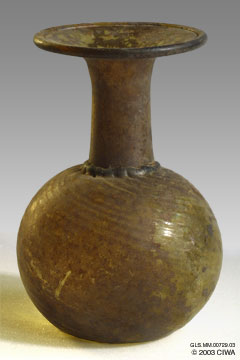Spiral pattern-blown sprinkler flask, Syria

Links to other views:⇒ Larger Viewif scripting is off, click the ⇒ instead. Links to others of type Sprinkler flaskGlass sprinkler flask, Syria, 280-320 ADGlass sprinkler flask, Syria, 280-325 AD Herringbone sprinkler, Syria, 1-300 AD Herringbone sprinkler, Syria, 250-320 AD Iridescent pattern-blown sprinkler, Syria Iridescent sprinkler flask, Syria, 250-320 AD Iridescent sprinkler flask, Syria, 250-320 AD Iridescent sprinkler flask, Syria, 250-320AD Pomegranate sprinkler, Syria, 250-320 AD Ribbed pattern-blown sprinkler flask, Syria Ribbed pattern-blown sprinkler flask, Syria Ribbed pattern-blown sprinkler flask, Syria Ribbed pattern-blown sprinkler flask, Syria Ribbed pattern-blown sprinkler flask, Syria Ribbed pattern-blown sprinkler flask, Syria Ribbed pattern-blown sprinkler flask, Syria Spiral pattern-blown sprinkler flask, Syria Spiral pattern-blown sprinkler flask, Syria Spiral pattern-blown sprinkler flask, Syria Spiral pattern-blown sprinkler flask, Syria Spiral pattern-blown sprinkler flask, Syria Spiral pattern-blown sprinkler flask, Syria Spiral pattern-blown sprinkler flask, Syria Sprinkler glass flask, Syria, 280-320 AD Sprinkler glass flask, Syria, 280-320 AD |
This understated, yet remarkable yellow-green transparent glass sprinkler exhibits uncommon levels of quality and precision in craftsmanship. Below a perfectly symmetrical, gently slanted wide rim with crisply infolded lip, the flaring mouth yields to a straight neck concealing a diaphragm at the junction with the body. A gathering of material from the body wraps around the neck to hide the constriction with a fringe. The perfectly shaped spherical body is adorned with a tight spiral pattern imparted by pattern blowing. The bottom is smooth, with a slight concavity and a small pontil mark. Syria, Eastern Roman Empire, late third to early fourth century AD. “Most sprinklers with this type of surface pattern probably date from the late third and early fourth centuries… such sprinklers were made in more than one workshop, but probably not over a long period of time, because relatively few have been preserved… expanded mold-blown ribs created in a one-piece conical mold [is] a technique that is not common with sprinklers” (Stern, 2001:153). Parallel “Sprinkler flask. yellow-green glass. This flask made out of a thick glass fabric has a spherical body decorated with swirling horizontal ribs. The tubular neck flares out to a wide horizontal infolded rim. At the base of the neck is a tooled constriction ring. Patching of dark weathering crust. Eastern Roman Empire, 3rd. - 4th. century AD ” (Fortuna 1991:53 #85). Glass Sprinklers Sprinkers are bottles made with a constriction in the neck resembling a washer. This constriction regulates the flow of contents to a trickle, which is helpful with products that must be dispensed parcimoniously. The level of care in the decoration of sprinkers suggests that their contents were luxury items such as expensive fragrances. “[Sprinklers were] Made and widely used in Syria, Eastern Palestine, and Mesopotamia… The earliest sprinklers on record are those from Dura Europos in north Syria which date from before 256 when the city was abandoned… Production continued throughout the fourth century and perhaps into the fifth century. It has not been established when the sprinkler became obsolete. Syrian glassworkers made a large variety of vessels into sprinklers, simply by squeezing the neck with jacks and bushing the body up against the cut-in to create the diaphragm. Jars, tubes, amphorisks, and head-shaped flasks were occasionally finished as sprinklers” (Stern 2001:152). Glass Pattern-Blowing The pattern blowing technique consisted of inserting a blob of molten glass at the end of a blowpipe into a tapered one-part mold that would give it surface texture, pulling it out, and then inflating it. It was a particularly effective way to create ribbed patterns, which could be swirled if desired. It “was probably developed in the late third or early fourth century [AD] by Syrian glassblowers who began to expand geometric patterns made in full-size, multipart molds” (Stern 2001:27). “The fourth century was an innovative period in the history of mold-blowing… The real success story was to be the straight walled, tapered mold with ribbing or fluting on the interior. Easy to make and easy to use, the mold enabled the glassblower to create a large variety of expanded vertical and spiral ribs. Immediately popular throughout the Roman Empire, pattern-blowing with expanded ribs was destined to become a lasting success that returned to mold-blowing some of its original appeal. The delicate ribs evoked the luxury of fine fluted silverware, but without the odium of mass production. The glassblower shaped each piece individually with his breath” (Stern 2001:134). “Expanded mold-blown ribbing is nowadays made by blowing into a one-piece vertically fluted, conical mold. Several variation on the technique exist, but the basics are the same. After extraction from the mold, the ribs are either left straight or they are twisted by pressing the pointed end of the glass paraison against the marver (or in the mold) and turning the pipe. After this the glassblower blows and shapes the piece. The mold is used only to impart a surface pattern, the vessel is free blown. Usually, the ribs spiral counterclockwise, because the glassblower turns the blowpipe clockwise, the normal direction for a right-handed person” (Stern 2001:201). Bibliography (for this item)Fortuna Fine Arts, Ltd.,1991 Shining Vessels: Ancient Glass from Greek, Roman, and Islamic Times. Fortuna Fine Arts, Ltd., New York, NY. (53 # 85) Stern, E. Marianne 2001 Roman, Byzantine, and Early Medieval Glass; 10 BCE-700 CE; Ernesto Wolf Collection. Hatje Cantz Publishers, Ostfildern-Ruit, Germany. Bibliography (on Glass Sprinklers)Stern, E. Marianne2001 Roman, Byzantine, and Early Medieval Glass; 10 BCE-700 CE; Ernesto Wolf Collection. Hatje Cantz Publishers, Ostfildern-Ruit, Germany. (152) Bibliography (on Glass Pattern-Blowing)Stern, E. Marianne2001 Roman, Byzantine, and Early Medieval Glass; 10 BCE-700 CE; Ernesto Wolf Collection. Hatje Cantz Publishers, Ostfildern-Ruit, Germany. |